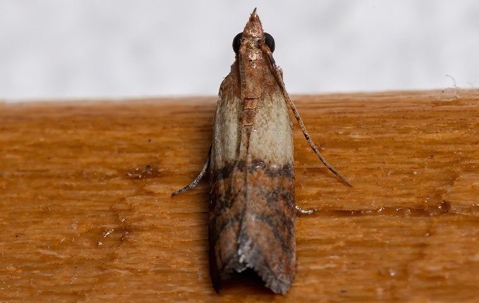Pantry moths are deplorable home companions and a nightmare in the pantry. While these little guests come out of the blue uninvited, there are reasons why they’re persistently ubiquitous in most home pantries.
In essence, you get moths in your pantry because they are attracted to the food that is stored there. Moths fancy dried processed food, including cereals, grains, bread, pasta, and flours, and since the pantry is the perfect storage place, you’ll mostly find them around there.
Moths are most destructive during the larvae stage and they bore through food and thin plastic. However, it’s hard to find them exposed to light due to their nocturnal nature, and larvae will bury inside dried food granules, only coming out at night when it’s dark enough for an open feast.
What Do Pantry Moths Eat?
Regardless of their stage of growth, pantry moths munch on any dried, starchy food items in the pantry. They bore through thin plastic and paper during their larvae stage to access dried, processed food.
You’ll also be surprised to find them in tightly sealed containers with dried food, where they’ll render it inconsumable.
Adult pantry moths usually lay eggs in open containers, and even after eliminating them, they leave behind eggs that hatch inside the sealed food packages.
The biggest downside for an infestation of these tiny creatures is that, in addition to degrading food, they also carry viruses and bacteria that can affect the health of humans and their pets.
What Are The Typical Signs Of Pantry Moths?
When pantry moths show up, they leave a clear trail behind. Whether you do regular pantry inspections or you occasionally scan through, it’s easy to spot the signs of a pantry moth infestation from afar.
Since every creature that feeds, must defecate or secrete, these insects are not an exception. From a closer look, you’ll notice your food clamping together, mainly when dry. Moth secretions are sticky, and they glue dry food particles together, forming clamps of varied sizes.
Besides, an unpleasant odor will top up the mess, and the food would be almost vile to eat. Another significant tell-tale sign of a pantry moth infestation is a trail of webs along with the corners of your pantry and a few toppings on the food.
Are Pantry Moths Harmful?
In addition to degrading food and making it unfit for consumption, moth secretions are a suitable breeding ground for bacteria that cause many diseases in humans.
Pantry moths also carry viruses that contaminate food, making it unhealthy to consume.
But the moths themselves are not harmful to people or pets. However, since they are ideal carriers of viruses and bacteria, it classifies them as both destructive and harmful. Pantry moths also cause losses for degrading fresh food purposed for long-term storage. For this reason, they can be harmful to your budget as they will force you to replace it with a fresher stock.
How Long Do Pantry Moths Live?
It’s challenging to agree on the exact lifespans of these tiny insects. However, pantry moths live through phases and undergo a complete metamorphosis spanning 7 to 12 weeks on average.
An adult pantry moth lives between 5 to 25 days maximum and can survive without food for two weeks. Moths in the house will consistently reproduce in areas with sufficient food and enough closure, unlike in the wild where breeding is seasonal. Thus, don’t expect them to go away after the lapse of their lifespans.
Where Do Pantry Moths Hide During The Day?
Pantry moths are nocturnal and typically come out at night to feed and mate. You’ll also spot them on LCD screens with blue light at night since it appeals to them. It, therefore, begs the question why are pantry moths out of sight during the day and where do they hide in your house?
Since they are active only after dusk, they usually find refuge in darker and shaded places in your home. They will perch on higher walls and ceilings, under furniture, and inside cabinets. They also hide in the webs they form on corners of your pantry and wait until it’s all dark and safe to emerge.
How Many Moths Is An Infestation?
Conventionally, it’s not typical for pantry moths to create an infestation in a home when conditions don’t favor them. However, the proximity to food sources makes it ideal to set up camp in your house.
Typically, a pantry moth infestation comprises 5 to 9 pantry moths, and any higher numbers define a severe infestation. Even if the problem doesn’t seem widespread, you shouldn’t be blind to the threat of pantry moths in your home. To prevent their populations from spreading further, inspect your Athens home – or precisely, your pantry – and eliminate them immediately by killing them or using repellents.
If you’re already dealing with a serious moth infestation, your best bet is to call in the pest control professionals.
Our exterminators are specially trained to find even the smallest entry ways and hiding places for various pests in your home. If you live in the Metro Atlanta area, contact our team at American Pest Control for help to eradicate your pantry moth infestation.
We’ve made it easy for you – it’s convenient to schedule your free inspection by either calling or emailing us, or filling out the contact form on our home page, and one of our friendly customer service representatives will be happy to assist you with our Athens, GA pest control services.
Our certified pest experts will work with you to find the best solution for your needs. Simply fill out this form for a free, no-obligation estimate.
Contact Us Today!

